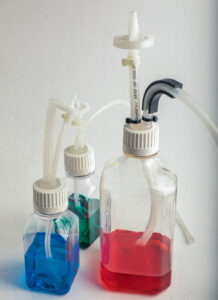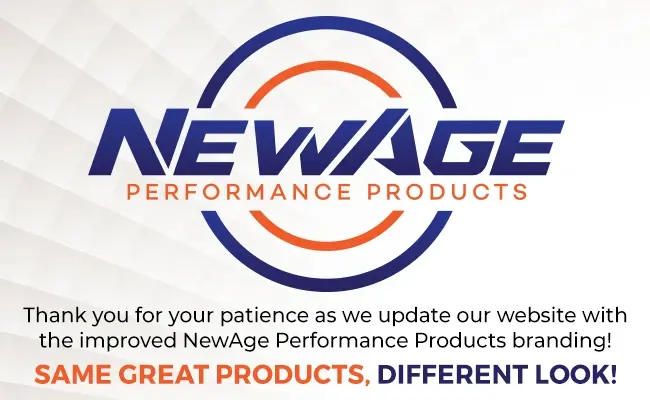We use injection molding processes here at NewAge, which involves our high-purity AdvantaPure® product line. BioClosure® container closures are injection molded using liquid silicone rubber or our AdvantaFlex® TPE (thermoplastic elastomer) material.

Single-use molded tubing assemblies are also made by injection molding. Our proprietary process combines extruded silicone tubing or braid-reinforced hose with liquid silicone to form molded connections in shapes such as wyes, tees, crosses, and reducers. Multiple connections can be incorporated into a single, finished part. AdvantaFlex tubing assemblies are made similarly.
Other types of molding processes for plastics and rubber include:
Extrusion Blow Molding – Extrusion blow molding is a process that can create hollow parts quickly across a variety of large and small applications. The process starts with the formation of a long hollow tube of plastic called the parison. The parison is extruded downward until it extends past the bottom of the mold, the mold then closes upon the parison. At this stage of the process, air is introduced via a blow pin at the top of the part, or a needle in the middle of the part, inflating the plastic and pushing it to the surface of the mold. Air pressure is maintained for the part to maintain contact with the surface through the cooling cycle of the process. Extrusion blow molding is used to produce a wealth of items, including large containers, gas tanks, toys, and 55-gallon drums.
Injection Blow Molding – This process is a variation of extrusion blow molding where instead of extruding a parison, an injection molded preform is produced. Typically, the preforms will resemble test tubes and are injection molded first. Then in either the same machine or a different machine, they are transferred to the blow molding stage of the process. During which it is conditioned with either heating or cooling to the correct temperature to blow the preform into the shape of the desired molded part. Once it is properly conditioned, air is introduced at the neck of the part, blowing it out to the surface of the mold surfaces to form into shape. Once it takes the shape of the mold, pressure is maintained to allow good contact with the mold for proper cooling of the part. Injection blow molding is often used to make seamless bottles.
Compression Molding – Compression molding can be used to form parts from both thermoplastic and thermoset materials. The base material is loaded into the cavity of the mold. The mold is then closed, and equal pressure is applied across the part. At this point the material cures to form the shape of the intended part. Once cured the mold then opens and releases the part. Compression molding is utilized to rapidly produce plastic bottlecaps but is also used to make the soles for shoes.
Rotational – Rotational molding is a polymer processing technique that creates seamless, hollow parts using a rotating metal mold and heat. A polymer in micro-pellet, powder, or liquid form is placed into a mold, which is then rotated on two or more axes. Conventional rotomolding machines use large ovens to heat the entire carriage assembly, whereas state-of-the-art machines allow for the mold to be heated directly. As the mold is heated, a melt pool forms at the lowest point of the mold. Each rotation through the melt pool deposits a new layer of polymer, gradually building up to the product’s target wall thickness. This process allows for unique parts to be produced without weld lines, in odd geometries, and at large product sizes. Rotational molding can be used for producing kayaks, water storage tanks, ice coolers, gasoline/diesel tanks, trash cans, and more.
Transfer Molding – Transfer molding is like injection molding in that the plastic or rubber material is put into a closed mold to form parts. It differs, however, in that a container placed above the mold or within the mold which material is first placed in and melted. Once melted, it is pushed into the mold using a plunger. Inserts such as wires or circuit boards can be placed in the mold before the plastic or rubber material is transferred, thereby encasing the inserts.
The extrusion process is referred to by some as extrusion molding, but here at NewAge we simply call it extrusion. No molds are used. Tubing is manufactured by forcing melted plastic or rubber through a die that forms the shape. The tubing runs through cooling water baths or heated cure towers to set its form.
Another process that sets plastic into a specific shape is heat forming. It’s a process that takes tubing or reinforced hose which has already been extruded and shapes it into a custom form by means of heat and custom fixtures. Shapes such as elbows, flared ends, and retractable coils are possible.
Learn more about our extrusion process, heat-formed shapes, or our AdvantaPure products.
If you have questions about the different types of molding or how it can help your project, phone us at 800-506-3924 or 215-526-2300, e-mailinfo@newageindustries.com, or use the Contact Us form below.


